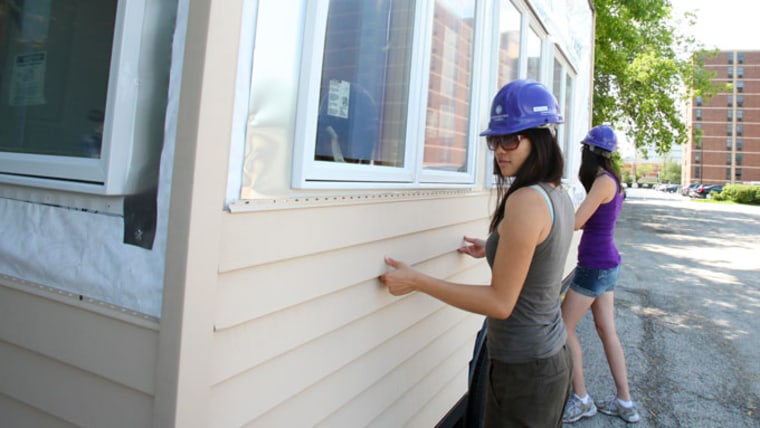How much space do you really need to live? No more than 128 square feet – about the same footprint as the trailers lawn care companies use to haul their gear, according to a team of college students and recent alumni keyed into the sustainability movement.
The team is putting the finishing touches on their tiny house which, in fact, was built on a trailer and is completely self-sustainable. It generates all the water and electricity its dweller needs, a first, they say, for this class of miniature housing.
"You can go anywhere you want and do anything," Kaycee Overcash, a recent graduate from Northwestern University in Evanston, Ill., who is the co-project manager for the Tiny House project, explained to me.
A 1,120-watt array of solar panels mounted on the roof coupled with a battery bank generates enough electricity to power a small refrigerator, lights and a laptop, the team says. A rainwater collection system fills up a pillow stored beneath the home, providing 8.4 gallons of water per day, year round.
That water and electricity, though, aren't used to flush the toilet. The house has a composting toilet outfitted with peat moss and a ventilation system that is slotted into the shower, which is actually where the entire bathroom is contained.
"It is a little bigger than a normal toilet because of the area it needs to decompose, but you sit on it like any other toilet," Overcash said. "You take a tray out once a week and it is dirt. You put it in your garden."
The overall goal of the project, she added, is to create a house that has everything you need, but nothing more. Even if people don't downsize to tiny houses, she hopes they'll at least take some ideas from a visit to the Tiny House and implement them in their own homes.
"We want people to understand how to start using their space better, their resources better, and they can do it with any of these technologies," she said.
A key goal for the project team was the implementation of off-grid technologies, a step that takes the tiny house movement away from reliance on municipal utilities and helps homeowners tune in to their surroundings such as the patterns of the sun, according to co-project manager William Fan.
"Water and electricity have become so cheap that we forget how difficult it is to obtain them," he told me via email. "Internalizing this process forces the user not to live beyond nature's means."
And while there's efficiency in the economies of scale that come with grid-size utilities, going off grid helps foster innovation, he added.
"Off grid systems have the ability to evolve more quickly, as they are smaller systems that don't require nearly as much capital cost and are chosen by families or individuals rather than bureaucratic governments," Fan said.
More on small, green homes:
- Living small looms large amid real estate bust
- CES to highlight tech for greening homes
- Eco-friendly homes multiply across the U.S.
- Inventor awarded for eco-friendly homes

is a contributing writer for msnbc.com.
